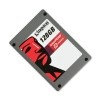- Qualcomm Launches Snapdragon 4 Gen 2 Mobile Platform
- AMD Launches Ryzen PRO 7000 Series Mobile & Desktop Platform
- Intel Launches Sleek Single-Slot Arc Pro A60 Workstation Graphics Card
- NVIDIA Announces Latest Ada Lovelace Additions: GeForce RTX 4060 Ti & RTX 4060
- Maxon Redshift With AMD Radeon GPU Rendering Support Now Available
Kingston SSDNow V Series SNV425 128GB

Like so many other memory vendors on the market, Kingston offers a wide array of solid-state disks for your perusal. For the low-end segment, it has the SSDNow V series, which at current time offer the best GB/$ on the market. We’re taking a look at the latest release here, combining a recent JMicron controller with Toshiba NAND.
Page 9 – Real-World: Windows Experience, Boot Times, Game Level Loading
Windows Experience
This is a test that any Windows 7 user can perform on their own system without needing to download anything. For those curious, Vista should allow the same, but we can’t guarantee the results will be directly comparable due to changes made in the WinSAT program. To run the program, hit the Windows Key + R at the same time, and type cmd into the run box. In the command prompt window type (or right-click and paste) the following without quotes: “cd c:windowssystem32” and hit enter. Once there input, again without quotes: “winsat disk -drive c -ran -write -count 10” and enter again.
This command runs a small portion of the Windows Experience Index’s drive assessment, specifically it uses small random writes and calculates how fast in MB/s the drive can sustain it. As we mentioned before with the HD Tune results, regardless of what drive is in question, its actual performance depends on what file size is being referred to. The smaller the file size, generally the lower the performance for a hard disk drive. So again, the small random file writes will be brutal.

The SNV425 does acceptably here again delivering results in the middle of the pack, and significantly above those capable by a mechanical drive. While the G1 is capped by its firmware to 80MB/s writes, we theorize that the combination of the small file size used for the WEI test and the drive cache combined to give it this final result. Even so, unlike the SiliconEdge Blue’s results, the G1’s result will not hold for large files or continuous small file writes.
Boot Time
For the boot test, we perform a cold boot, with the stopwatch starting the moment the power button is pressed until the last systray icon has finished loading. A large number of factors can change how fast a computer boots, from motherboard to just the BIOS configuration, so these times should not be used as an expectation of how fast the SSD will boot in your respective system. With some newer motherboards condensing the time taken in the boot process, boot times could reach significantly lower than these.

Here the SNV425 again performs acceptably, managing to just edge out the OCZ Summit’s results. The drive’s results in the light batch test serve as a better example of the SNV425’s capabilities in a boot test, however.
Game Level Loading
Last, but certainly not least, are the game level-loading times. SSDs tend to improve application load times significantly over their mechanical brethren, and games are no exception.
Crysis is still infamous for how well it could stress the entire PC, and although Crysis Warhead was a significant improvement and much better optimized than its predecessor, it still makes for one of the better gaming benchmarks to use. For this test, we timed how long it took to load the first level, Ambush. We also figured we would use the newer Left 4 Dead 2 game, for its slightly longer-than-average load times. Here, we timed how long it took to load the final chapter in the Hard Rain campaign.
While the difference between the best SSD and the typical HDD almost exactly halves the game loading time, that 15 seconds really doesn’t seem like much in L4D2, or 30 seconds in Crysis Warhead. At least until considering that each level load is one of many, then halving the load time really starts to add up. Some games involve quite a few load points or build them directly into the level (Half Life 2 being a good example), and smoother, more fluid transitions will greatly preserve game the immersion. In which case, for some gamers the answer becomes a definite yes.

As with all the results the mechanical hard drive falls into its own distant category, with any SSD dropping the load times by almost half. Performance here is bottle-necked by some other constraint, potentially the CPU given we are using a slower quad-core versus a faster dual-core processor.
Support our efforts! With ad revenue at an all-time low for written websites, we're relying more than ever on reader support to help us continue putting so much effort into this type of content. You can support us by becoming a Patron, or by using our Amazon shopping affiliate links listed through our articles. Thanks for your support!




